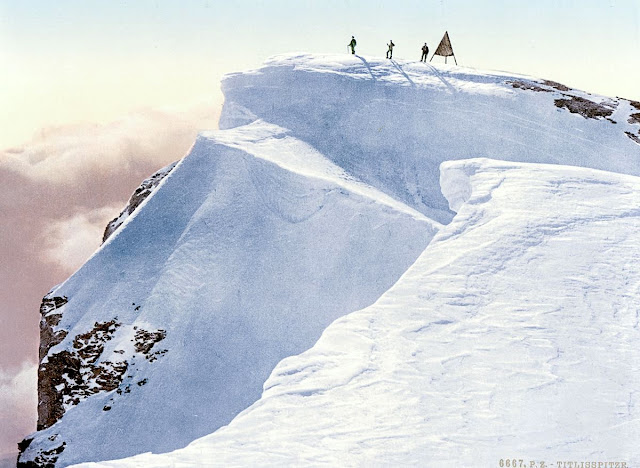VITTORIO SELLA (1859-1943)
Mount Ushba ( 4,710m)
Géorgie
In Le double sommet du Mount Ushba, photographie à la chambre in situ, 1889-90,
The Royal Geographic Society
La montagne
L'Ushba (4,710m) est l'un des sommets les plus remarquables du Caucase. Il est situé dans la région de Svanétie en Géorgie, juste au sud de la frontière avec la région de Kabardino-Balkarie en Russie. Bien qu'il ne figure pas parmi les 10 plus hauts sommets de la chaîne, l'Ushba est connu sous le nom de « Cervin du Caucase » en raison de son pittoresque double sommet en forme de flèche. L'Ushba est considéré par de nombreux alpinistes comme l'ascension la plus difficile du Caucase.
Dans la mythologie géorgienne, l'Ushba était considérée comme la demeure de la déesse de la chasse Dali.
Le sommet sud de l'Ushba est légèrement plus élevé que son sommet nord, qui culmine à 4 690 m (15 387 pieds). Le sommet nord a été gravi pour la première fois en 1888 par John Garford Cokklin et Ulrich Almer, tandis que le sommet sud a connu sa première ascension en 1903 par une expédition germano-suisse-autrichienne dirigée par B. Rickmer-Rickmers.
Le sommet nord de l'Ushba est plus accessible que le sommet sud : la voie standard, l'arête nord-est, monte du côté russe de la chaîne jusqu'à un haut plateau et de là jusqu'au sommet. (Ainsi, une ascension au sommet par cette voie implique techniquement de traverser la frontière.) L'itinéraire est classé AD+ français ou 4a russe. Les itinéraires sur le sommet sud, du côté géorgien, comprennent deux itinéraires classés ED français.
Avant la découverte à la fin des années 1980 du pic 4810 à Karavshin, Ushba, ainsi que Chatyn-Tau et le pic Free Korea au Kirghizistan, étaient considérés comme les sommets les plus difficiles et les plus prestigieux à gravir dans l'ancienne Union soviétique. L'ascension de l'Ushba est devenu très périlleuse en raison du changement climatique. Plusieurs alpinistes y trouver la mort ces dernières années.
Le photographe
Vittorio Sella est un alpiniste et photographe italien qui a hérité sa passion pour la montagne de son oncle, Quintino Sella, fondateur du Club Alpin Italien. Il a réalisé de nombreuses ascensions remarquables dans les Alpes, le premier hivernage au Cervin et au Mont Rose (1882) et la première traversée hivernale du Mont Blanc (1888) et des Rouies (1900).
Il a participé à diverses expéditions hors d'Italie :
- Le Caucase en 1889, 1890 et 1896 (où un sommet porte encore son nom)
- Le Mont Saint Elias en Alaska en 1897 ;
- Le Sikkim et le Népal en 1899 ;
- Peut-être l'ascension du Mont Stanley en Ouganda en 1906 lors d'une expédition au Rwenzori ;
- La reconnaissance au K2 en 1909 ;
- Au Maroc en 1925.
Lors d'expéditions en Alaska, en Ouganda et au Karakoram, il accompagne le duc des Abruzzes, le prince Luigi Amedeo di Savoia.
Sella continue la pratique de l'escalade jusqu'à un âge avancé, réalisant sa dernière tentative au Cervin à l'âge de 76 ans ; une ascension dont il dut interrompre l'ascension suite à un accident dans lequel l'un de ses guides se blessa. Il mourut dans sa ville natale pendant la Seconde Guerre mondiale. Sa collection photographique est aujourd'hui gérée par la Fondation Sella.
Ses photos de montagne sont encore aujourd'hui considérées comme parmi les plus belles jamais réalisées.
Jim Curran estime que "Sella reste probablement le plus grand photographe de la montagne. Son nom est synonyme de perfection technique et de raffinement esthétique."
La qualité des clichés de Vittorio Sella s'explique en partie par l'utilisation d'une chambre photographique 30 × 40 cm, malgré la difficulté du transport d'un tel appareil, à la fois lourd et fragile dans des endroits inaccessibles ; pour pouvoir le transporter en toute sécurité, il a dû fabriquer des pièces spéciales pouvant être rangées dans des sacoches de selle. Ses photographies ont été largement diffusées, soit par la presse, soit dans les galeries, et ont été unanimement saluées ; Ansel Adams, qui a pu en admirer trente et une lors d'une exposition organisée au Sella American Sierra Club, a déclaré qu'elles lui inspiraient « un sentiment religieux d'émerveillement ». Beaucoup de ses images ont été prises en montagne pour la toute première fois dans l'Histoire, ce qui leur confère une dimension artistique et historique beaucoup plus importante aujourd'hui.
______________________________________
2024 - Gravir les montagnes en peinture
Un blog de Francis Rousseau
%20-%20Mount%20UShba%20(%204710m)%20-%201889-90%20CAucase.jpg)





-%20K2%20%20in%201909.jpg)







